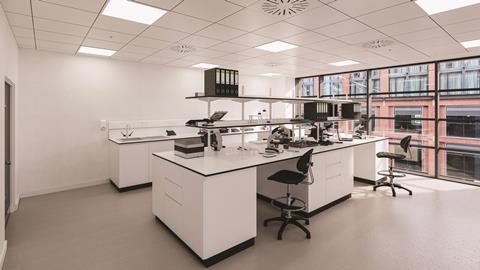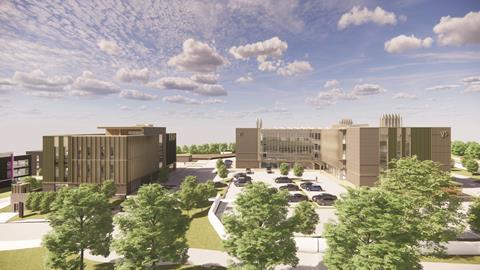“The big shift has been science becoming more data-driven,” says James Sheppard, managing director for the UK and Ireland at specialist developer Kadans Science Partner.
“The skillset required by big pharmaceuticals has changed. They now want data scientists, bioinformaticians and computer scientists to sit alongside traditional wet-lab roles.”
Hunting for graduates with these emerging talents requires a fundamental employer rebranding for many companies.
“Data scientists typically live in cities and come out of university with job offers from Google, Apple and Facebook,” says Sheppard. “Do they want to work on a business park in the middle of nowhere behind a barbed-wire fence? No.”
Pharmaceuticals giant GSK signed a deal at the end of last year to move its global headquarters from Brentford to the West End, with chief executive Emma Walmsley hailing the chance for “even closer collaboration with the city’s world-class science, academic and healthcare institutions”.
The science driving a market has a direct influence on the real estate
Chris Walters, JLL
It is a move Sheppard says reflects an industry-wide drive to be nearer – and more attractive – to a new wave of talent. “Big pharmaceuticals are adapting their real estate strategy,” he says. “We see a lot more hub-and-spoke: two or three research hubs across the world where you invest billions in long-term projects, then lots of spokes that reach into pockets of excellence.”
Siting buildings in places people can and want to access is critical, says Sheppard, as is ensuring they offer top-quality places to work.
“Scientists are people, too,” he laughs. “They like nice restaurants and bars. Lifestyle is really important, and design quality as well. People are saying they don’t want to work in dimly lit basements.”
Docklands cluster
Kadans is working with Canary Wharf Group to create a new cluster of modern life sciences facilities in London’s Docklands area. The joint venture’s 23-storey North Quay development is scheduled for completion in 2026, while its hyper-flexible 38,000 sq ft building at 20 Water Street is close to opening. Here, small firms will be able to take space from a single bench upwards for periods as short as 30 days.
“We have seen the rate of innovation in science get quicker,” says Sheppard. “People don’t want 10-year leases when they know within 18 months whether a project will work.
“We also see talented academics looking at creating projects on the side but who can’t afford to take a private lab. We provide ecosystem support – access to funding, talent and space. It is like a scientific concierge service.”
This is just one of a huge wave of schemes opening in the sector. The volume of existing laboratory space in the life sciences sector has grown by almost one third in the past five years across the so-called ‘golden triangle’ of London, Oxford and Cambridge, according to JLL.
The property agent says it is tracking active demand for a further 2.5m sq ft in those three cities – more than the total space they had in existence in 2018.
While Covid and the vaccine race pushed the sector into the limelight, it was underlying trends that truly created this explosion in the sector, according to Chris Walters, JLL’s head of UK life sciences.
“On a macro level, the biggest driver has been the ageing population and therefore the necessity to find new breakthroughs and technologies to improve health,” he says.
However, investment has diversified since 2020, Walters adds. “It’s [coming from] a mix of private individuals, equity, pension funds and sovereign wealth. There are more investors now thematically committed to life sciences, and we have seen new entrant developers and operators.
“It’s a mix of UK entities like Pioneer Group; US players like BioMed Realty; and other players like UBS, which has invested in Stevenage.”
Capital growth
While London has a smaller proportion of existing and actively demanded life sciences space than its Oxbridge rivals, the capital’s market could be “poised for strong growth”, believes Walters.
“London attracts 40% of all venture capital in the UK and has three of the leading academic institutions for life sciences in Imperial College, University College and King’s College,” he says. “It has the anchors that the companies look for to attract employees to their business – so the investment opportunity is also strong.”
Even resi developments are being edged out by life sciences
Rebecca Mortimore, Ramboll UK
While the golden triangle is still far ahead of the rest of the UK in terms of the infrastructure for life sciences to thrive, clusters of specialist activity are emerging elsewhere.
“There is fantastic research up and down the UK,” says Walters. “There are different specialisms born from the nature of academic research happening, which shapes the company profile in that cluster.”
Critically for the property industry, the type of science being undertaken in a particular city or campus dictates building requirements. From office-led space with certain added facilities through to fully flexible wet labs for advanced experiments, each company’s needs are different.
“We are working with clients spending significant resources to ensure they are delivering space fit for their market,” says Walters. “One building product will not suit every market; the science that is driving a market has a direct influence on the real estate.”
Rents have risen over the past few years as demand outstrips supply, and the right building in the right place for its market can create healthy returns, according to JLL.
“Investors are committing because from a financial perspective they can see the viability is stronger than for other asset classes.”
Jamie Renison, head of life sciences agency at Cushman & Wakefield, says the sector was “ticking along quietly as a minority part of the office market” just a decade ago.
Along with the pandemic and a rise in the availability of start-up funding, a shift of focus from treatment to prevention has trebled the size of the industry since 2015, he says. The use of artificial intelligence could see further evolution.
Despite the rush to build new space, demand continues to outstrip supply, according to Renison, fuelling “exponential rental growth” of up to 25% in a year in some places.
He echoes Sheppard’s thoughts on the “urbanisation” of the industry, adding that Manchester and Birmingham are seeing more interest alongside the traditional locations. However, demand in the golden triangle remains more than twice as high as the volume of space expected to come through in those cities in the next 18 months, according to Cushman & Wakefield analysis.
Collaborative focus
Rebecca Mortimore, director and science sector co-lead at engineering consultancy Ramboll UK, says modern life sciences are centred on collaboration, meaning the golden triangle will continue to lead the way.
“These locations provide the full ecosystem for life sciences research and development, including universities and teaching hospitals, access to finance and lifestyle factors that are essential for recruiting talent in a global industry,” she points out.
This leads to “massive competition for sites” and “even residential developments being edged out by life sciences developers”, Mortimore adds.
However, she says the cost-of-living crisis could offer an opportunity for cities including Bristol and Edinburgh to compete by offering more affordable alternatives. Areas with positive planning policies will also be sought by developers, she explains.
Wherever a life sciences hub is built, it needs to be flexible to appeal to a range of tenants and varying activities, she says. “This typically means a robust structure with decent floor loading, a back-of-house service area and tall floor-to ceiling heights to accommodate engineering services distribution.”
With so much research work taking place in UK laboratories at present, Mortimore posits that a fresh wave of later-stage facilities could soon be required.
“If a significant portion of current R&D is successful, we are likely to need commensurate provision of clinical trials facilities and, ultimately, manufacturing and production sites,” she says. “These spaces are far more expensive and more complex.
“The design and construction industry needs to put its mind to how these next stages of the life sciences property pipeline can be delivered potentially at scale, at speed and economically.”
Liverpool’s Sci-Tech expansion
Liverpool may not be a traditional hotbed for scientific innovation, but detailed plans have been submitted for two new life sciences buildings at the city’s fast-expanding Sci-Tech Daresbury enterprise zone.
Creating a combined 83,000 sq ft of space, V4 and V5 would sit alongside three earlier structures that are almost fully let.
The larger of the proposed buildings, V5, would feature dedicated Containment Level 2 laboratories along with areas to encourage collaboration and wellbeing, including an accessible roof terrace.
Floorplates of up to 20,000 sq ft, along with high ceilings, fume extraction and external door access, are designed to provide cutting-edge research space.
Both buildings have been designed to BREEAM ‘Excellent’ standards by Seven Architecture and feature solar photovoltaics and air-source heat pumps, as well as green roofs.
The earlier buildings at Sci-Tech Daresbury – V1, V2 and V3 – already provide a total of 43,000 sq ft of grade-A office and innovation space.
Jayne Furnival, property director at developer Langtree, says: “The remarkable take-up we have seen has been driven both by the arrival of leading international firms and existing campus companies scaling up, in line with our Home for Life ethos.”








































No comments yet